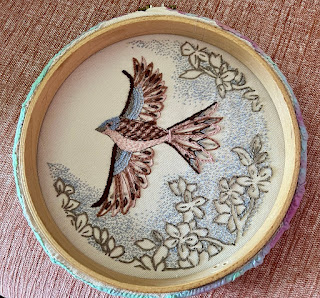
I bought one. In order to keep my promise not to add to my stash, I began work on it as soon as I finished the Swedish hand towel.
The instructions were clear and precise, with good illustrations. Although they suggested working the background first, I only did enough to see how it worked and moved on to the bird.
It was really interesting to stitch - a good variety of stitches, and never enough repetition to be boring.
The colours are so harmonious and calming. After the bird I returned to the background - fine for doing in front of television!
As I got towards the end, I had a class at the Guild, so went on a hunt on the trading table for a bamboo hoop I could use to frame and hang it, without using one of my working hoops. I found one, came home and finished off the stitching.
This morning, before breakfast, I mounted the finished item in the trading table hoop. It took a bit of manipulating and tugging to get it tight enough.
I then found another Guild treasure, a piece of cloth dyed by Guild members for an exhibition challenge a couple of years ago. It was the best colour blend in my stash for backing the hoop frame.
It was a little tricky stitching the backing on, but a lot of pins helped.
It is now hanging on my front door, along with the two other pieces that have been there for a year or two. My neighbours are supportive.
It's been an uplifting project to work on - some challenges, but calming and joyful. I recommend it - for learning, for stitching satisfaction and joy.
I have not provided detailed photos of my work on this one in order to preserve copyright. My photos show no more than the promotional photos of the kit show.
When I published this blog post, Create in Stitch still had the kit in stock. I'm sure it's available from other retailers, as well as the Bluebird Company itself.
 I have just constructed this bag from Carol Stacey's Whitework Pulled Thread class that I attended at the Guild over the last two Sundays. I had selected a piece of green silk as lining, but it proved to be a bit short, so I used some rayon lining fabric I had been given by a dressmaker years ago.
I have just constructed this bag from Carol Stacey's Whitework Pulled Thread class that I attended at the Guild over the last two Sundays. I had selected a piece of green silk as lining, but it proved to be a bit short, so I used some rayon lining fabric I had been given by a dressmaker years ago. 































